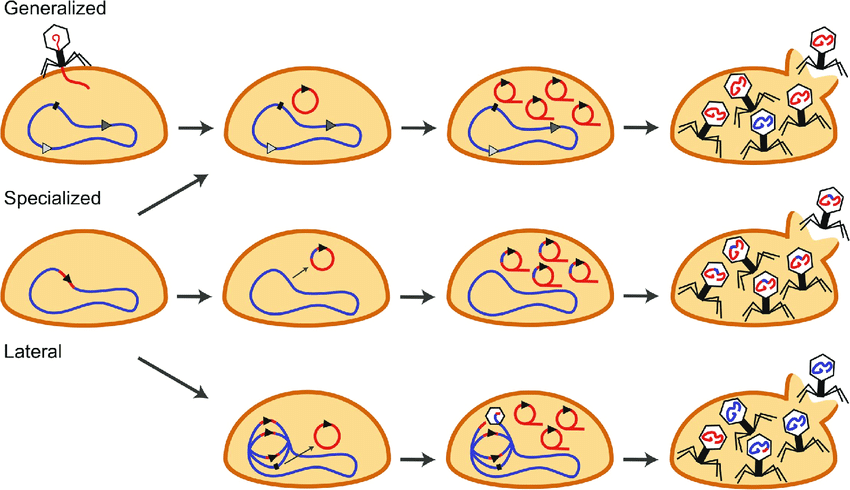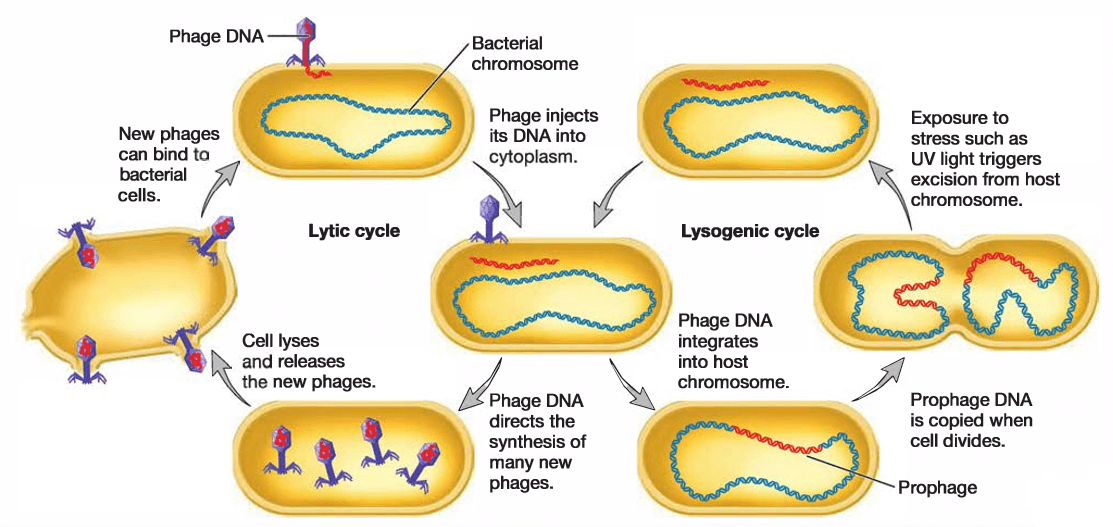Transduction in Bacteria
In this process, bacteriophages (bacteria infecting virus) function as vectors to transfer the genetic material DNA from the donor bacterial cell to the recipient cell. Transduction of bacterial genes by bacteriophage was introduced by Lederberg and Zinder in 1951 in Salmonella typhumurium. Transduction processes are of two types – generalized and Specialized. Transduction is a common process used by many biologists to introduce DNA from one to another cell.

The process is also known where foreign DNA is transferred into another cell through a viral vector. It does not need a physical connection between the donor cell transferring DNA and the recipient cell receiving the DNA which usually occurs via conjugation.
The generalized transduction includes the process where phages produced during lytic cycle growth are not normal and contain an unknown fragment of bacterial DNA other than phage DNA.

Generalized Transduction
In generalized transduction, firstly the bacteriophage infects the donor bacterial cell and starts the lytic cycle which results in an infected virus particle with bacterial DNA but that virus can no longer replicate in the bacterium due to the lack of all phage DNA in the cell.
The phage then goes and attaches to the cell surface receptor of bacteria and penetrates the packaged DNA in the cytoplasm of the bacteria.
If the DNA in the bacteriophage is originally from the bacterial chromosome, then the DNA gets recombined with the similar kind of DNA present in the recipient bacterial cell to produce stable transductants. This whole process requires RecA, a host recombinase enzyme.
However, many research studies have indicated that most transduced DNA is not stably injected into the bacterial genome instead remains extra-chromosomal DNA.
This type of transaction, Generalized Transduction is utilized for gene mapping technique, mutation, transfer of plasmid and transposon,
However, studies have indicated that the majority of transduced DNA is not stably integrated into the bacterial genome but rather remains extrachromosomal.
Steps of Generalized Transduction
- The donor cell which is the phage host cell is infected with the phage, where the phage DNA gets incorporated into the cytosol of the bacteria.
- During the process of the lytic cycle, the phage DNA with the bacterial DNA gets broken down into smaller fragments.
- During the release, some parts of bacterial DNA are then packaged into a viral capsid (head) when it gets released by the lysis of bacteria.
- The transducing phage along with bacterial DNA then infects another bacterium which is the recipient bacterium and the donor DNA incorporates into the cytoplasm of that second bacterium.
- Then the donor DNA recombines with the homologous DNA of the recipient bacterial cell using the host recombinase recA to produce stable transductants.
Applications of Generalized Transduction
- It is used for gene mapping technique
- It works well in mutagenesis, transfer of plasmid and transposon.
- Identification of genes belonging to the same or different genera of bacteria.
Specialized Transduction
In this type of transduction, the phage of bacterium goes through lysogeny at particular locations in the genome of bacteria. These specific sites are called attachment sites.
Similar to the above phenomenon, the phage genome also gets integrated into the chromosome of bacteria like during the lysogeny, the virus integrates its genome into the bacterial chromosome. The phage genome then gets removed from the bacterial chromosome and because of spontaneous excision and recombination, the bacterial genes present adjacent to the phage genome also get removed.
The specialized transducing phage contains both the bacterial and phage genes. When the subsequent infection occurs, the newly acquired gene gets injected into the bacterial genome sliding along phage DNA to produce a new round of lysogeny cycle.
Specialized transduction is not dependent on host homologous recombination and host recombinase enzyme recA but it requires phage integration to proceed the process further.
Steps of Specialized Transduction
- After the donor bacteria and bacteriophage infection, the phage DNA enters the bacterial chromosome in the Lysogenic cycle.
- Some parts of bacterial chromosomes get removed during the imprecise excision of the phage DNA.
- Then the phage DNA with some part of the bacterial chromosome together infects the new host cell, and the donor DNA enters into the recipient bacterium during the lysogenic cycle of viral replication.
- Then, the recipient cell shows newly acquired genetic traits.
Applications of Specialised Transduction
- It acts as an important tool in molecular biology for the following reasons
- It helps in the isolation of genes
- Specialized transduction also has a role in the discovery of insertion elements that can be used as an attachment site for phage DNA integration.
Co-transduction
During the process of transduction, bacteriophages can package a maximum size of DNA segment into it. So, if two genes are placed close to each other on a chromosome, there is a chance that a bacteriophage may package a single fragment of the chromosome that carries both the genes and transform that fragment into another bacterial genome. This process is called Co- transduction.
A fact that two genes may undergo co transduction may depend on how close the two genes are located on the chromosome. However, if two genes are placed far apart from each other on a chromosome, co-transduction will never occur because the bacteriophage cannot package large DNA fragments physically.
Co-transduction can also be used to map genes on the bacterial chromosome. This mapping of genes relies on the fact that how close or distant two genes are placed on a chromosome. The closer the two genes are located, the higher will be the chance of co-transduction. That means the frequency of co-transduction is inversely proportional to the distance between two genes.
The life cycle of Bacteriophage

All phages require to carry out reactions to create more like themselves. Firstly, the phage has to recognize a bacterium that it can multiply by attaching it to the cell surface of the bacterium.
Next, the phage has to inject its genetic material into the cytoplasm of the bacterial cell.
Then, the phage genome has to be replicated, transcribed and translated. After all these, the full packaged phage genome is assembled into a new virion and escapes from the cell to infect another bacterial cell. There are two types of the life cycle of the virus. Lytic Cycle and Lysogenic cycle.
Significance of Transduction
- Transduction is a molecular tool used in many genetic engineering and biotechnology studies.
- Transduction can be used to incorporate genes of interest in animal or plant cells to modify their genetic constituents and obtain the desired phenotypic as well genotypic characteristics.
- It is also applied in gene therapy techniques. Transduction is highly useful to treat genetic diseases.
Example of Bacterial transduction
- A well-studied example of generalised transduction is P1 (phage 1) which can transduce DNA of E.coli to many gram-negative bacteria.
- A classic example of specialized transduction is E.coli phage lambda which integrates its genetic material between operons encoding enzymes responsible for the production of Galactose (gal) and Biotin (bio) in the E.coli chromosome.
